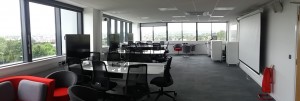We are only one week away from the start of term. I teach mainly to first year students and for many of them this will be the first experience of higher education. If you are a new student, this is how our teaching is organised: you will spend the vast majority of your time in labs doing something. A lot of people still have a very wrong idea of how learning happens: they imagine that learners are vases to be filled, with teachers standing in front of a class of 20 or so students, “filling” the heads of learners silently seated in front of them. In this vision, the role of the learner is just to remain passive while lectures or lab classes are delivered, and eventually transcribe verbatim what has been taught during an exam a few weeks or months later. In spite of this vision being a few centuries old, it seems to be still shared by many.
This is not what will happen in CS. As a student, most of the time you will be given a handout that you are supposed to read autonomously before coming to your scheduled labs. Some people call it the flipped classroom model, even if what we do is slightly different. We have exceptional new facilities, the rooms where you will work are similar to this one:
 As you can see, the room facilitates working in small groups or individually. Indeed, we know that each student can progress at a different pace and therefore we try to allow students who can go quickly through a topic to progress further, while other students may spend more time on topics that they find hard. In each session there will be academics and teaching assistants and all of us will be happy to switch between different groups working on different topics. We also make heavy use of tools such as Slack and we recommend you to join the team https://mdxcs16.slack.com/ where you will find a number of channels and a lot of people to discuss and ask questions, and we will have a number of drop-in sessions open to support you.
As you can see, the room facilitates working in small groups or individually. Indeed, we know that each student can progress at a different pace and therefore we try to allow students who can go quickly through a topic to progress further, while other students may spend more time on topics that they find hard. In each session there will be academics and teaching assistants and all of us will be happy to switch between different groups working on different topics. We also make heavy use of tools such as Slack and we recommend you to join the team https://mdxcs16.slack.com/ where you will find a number of channels and a lot of people to discuss and ask questions, and we will have a number of drop-in sessions open to support you.
I use often the metaphor of learning to cycle. Learning to code and learning mathematical concepts is similar to learning how to ride a bicycle. As a teacher, I could tell you on a board with drawings how to do this, and maybe using pictures and videos on slides. You could read a book about cycling and you may even learn racing tactics at Tour de France, writing essays about it and excelling in written exams about the topic. But are you really able to cycle? If you were to join a team at the end of such a cycling course you will be very unlikely to be able to cooperate effectively, and most likely you would struggle simply trying to balance.
Being able of doing Maths and coding are very similar to cycling. As a result, we want to observe you doing it, we don’t want to read your essay about it! Similarly to what happens with a bicycle, you will need to try, try, and try again. This is not going to be a linear process, you need to be persistent and continue trying even if you think that you are not making any progress. What you need is practice, something that you can do in the labs but also with individual study. As teachers, we will not read the handouts to you, you should read the bicycle manual! Our role is to look at how you cycle and suggest improvements; sometimes we may give you a stabilizer if you are leaning on one side, but then we will remove it and we want to observe you cycling alone. This is how you will be assessed: no exams, no essays, but just observation of your behaviours (more on this in another post or, if you are a student, check the handouts!).